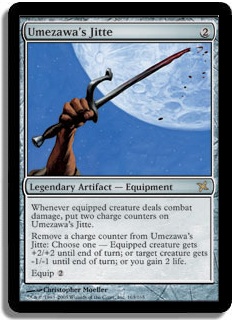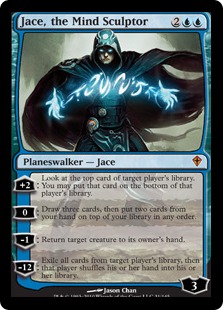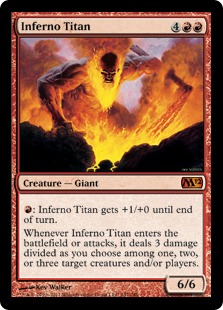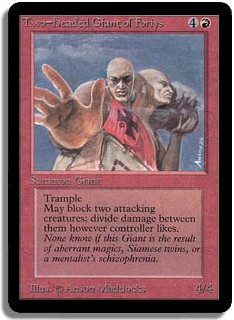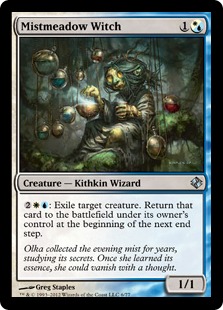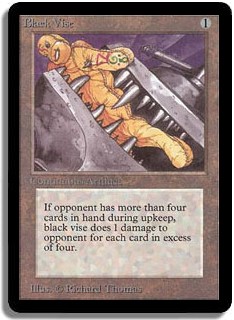In my opinion, the singular attribute of Magic: The Gathering that makes it so appealing is that the rules provide players with a framework that facilitates a boundless multiplicity of possibilities for different types of gameplay. As players, we are able to dictate and amend the rules under which we choose to explore different avenues the game provides.
In the past couple of weeks alone, I played Magic in several very different ways: a 45-player Standard Constructed tournament, a Block Constructed Pro Tour, Vintage at the kitchen table with a friend, a Booster Draft tournament, 1v1 Danger Room, and multiplayer Danger Room.
Each of these formats is very different, not to mention that the context is also very different. For instance, the level of competition and pressure of playing on a Pro Tour is very different from the relaxed nature of casual multiplayer. Magic, whether it is played by pros in a competitive pressure cooker with money on the line or casually by old pals around a kitchen table in a cabin, is consistent in the fact that it provides an engaging, challenging, fun, and thought-provoking experience.
All of that being said, today I’m going to talk about my pet format “The Danger Room.”
I first wrote about The Danger Room exactly one year ago in this article.
Creating my own format and watching it grow in popularity is my proudest achievement as a Magic player. It is a very surreal yet extremely satisfying experience to be on the other side of the continent in California for a Pro Tour and stumble upon people I have never met before playing a format I invented back home in Michigan.
I have had the opportunity to talk with countless people about The Danger Room, and I am asked on a weekly basis for my updated list. In today’s article, I’m going to touch on a variety of subjects related to my experience building and tuning my Danger Room stack, many of which can easily and usefully be applied to building and balancing any cube.
The basic premise of The Danger Room is that each player starts with ten lands in reserve outside of the game.

“Ten lands and infinite possibilities.“
Each turn a player gets to play a land from outside the game of their choice. Players draw cards from a large shared deck of cards (starting with six cards per turn and drawing a card from the deck each turn as per usual, with a maximum hand size of nine) and can cast those spells with their lands. There is no way to accelerate, ramp, or impede mana development, which means that players will always have equal access to resources.
While the rules for mana development are pretty clearly defined, everything else is dictated by the cards the deck designer chooses to include or exclude in the same manner that the decision to include or exclude specific cards from a cube (i.e., Power Nine) greatly changes the manner in which the games will play out.
Also, on a fun note I have finally (after six months) finished watching the entire Star Trek: The Next Generation series online. As I understand, the entire point of watching Star Trek is to suddenly have very strong and pronounced thoughts about it. In keeping with tradition, I will also be inserting into this article my “Top 10 Best Next Generation Episodes.”
#10: “Sins of the Father”
When I started watching TNG, my initial thought was that Worf was going to be a throwaway character that would ultimately be an annoyance. Battle boy Worf was going to be a combat crazed “space orc” who does the down and dirty, hand-to-hand combat for the good guys.
While in the early episodes of the show my initial read tended to be more true than false, the episode “Sins of the Father” dramatically departed from such tendencies and took full advantage of developing Worf as a fully-fledged, complex character. He is a man struggling with his notion of identity; he is “not” human but serves as an officer alongside humans. When he reconnects with his native Klingons in Sins of the Father, it becomes clear that despite his best effort to preserve his “Klingon-ness,” he is not only rejected by his countrymen but also does not fully agree with their ideology.
We also see in Worf’s decision to abandon his family honor for the greater good the capacity of an individual willing to undergo great sacrifice. While the Klingons place a great emphasis on their ideological construction of “honor,” it is ultimately Worf (the Klingon who is not-so-Klingon) that time and time again demonstrates the true understanding of what it means to be honorable. While every character on the Enterprise ultimately suffers throughout the season, it is my opinion that Worf’s suffering is most pronounced and prolonged. In many ways he reminds me of the Old Testament character Job, whose faith and beliefs are challenged and tested by extreme hardship but whose resolve and faith are unshakable.
My first and biggest mistake when designing my Danger Room was that the power level of the cards was too uneven. One of the guiding premises while designing the first version of the Danger Room deck I posted a year ago in “Enter The Danger Room” was that I deliberately chose to err on the side of making cards less powerful.
A guiding principle of the format was that I didn’t want to have cards that simply ended games because they were too powerful. I said that I felt 25% of Constructed games were lost to mana screw, 25% to mana flood, 25% to a ridiculous bomb that goes unanswered for a turn, and 25% of games were truly desirable experiences.
“Kill spell, Counterspell, or Bust.”
While I excluded cards like Umezawa’s Jitte, Inferno Titan, planeswalkers, and Consecrated Sphinx because I felt they would simply go crazy and win games on their own, I was perhaps too cautious at first.
The key to a good cube or big deck design is to have as many cards as possible approaching close to the same power level as possible. For instance, imagine a Community Chest card in Monopoly that says “You win the lottery! Get $1,000,000 and acquire all unowned property.” Obviously, this card would ruin the game every single time it’s drawn from the deck. Inversely, say the Community Chest is also filled with cards that said “It’s your lucky day! You get $1.” In Monopoly, $1 is basically worthless, and getting +$1 or -$1 is nearly the same as having no effect upon the game and becomes nearly the same thing as wasting a turn.
Advanced token to Boardwalk has upside and downside depending upon the state of the game, but either way it progresses the game in an interesting and significant way. Even Luxury Tax, which is a significant drawback, at least progresses the game.
In my initial list, I had too many +$1 cards that simply didn’t progress the game significantly enough.
#9: “Ship in a Bottle”
As a general rule, I groaned pretty much every time I realized I was about to spend the next 45 minutes engaged with a “Holodeck Episode.” “Ship in a Bottle,” however, is the exception to the rule.
I have always been a big fan of Sherlock Holmes and enjoy the idea the crew of the U.S.S Enterprise engaged in a battle of wits with Professor Moriarty, one of literatures most formidable and cunning villains. One of the attributes of TNG that I really enjoy is that it is extremely literary, which is heavily reflected in this episode. I have a Master’s degree in Literary Theory and really enjoy that I can approach episodes (and the series in general) as though they were texts.
One parallel I found extremely poignant while watching this episode is to Mary Shelley’s Frankenstein, or the Modern Prometheus, in which a human gives life to an artificial being and is then reluctant to provide that individual with the necessities to have a satisfactory or meaningful existence. When the creature (or in this case the self-actualized projection of Moriarty) requests companionship and freedom, it is denied to him and he is forced to take extreme and violent measures against humanity in order to achieve his means.
However, we find here (through the compassion and ingenuity of Jean-Luc Picard) a cunning compromise that diffuses the threat the “monster” poses to humanity while at the same time allows for the monster to live a fulfilling existence. The “holodeck-within-a-holodeck” ploy is among the most cleaver plot twists employed by the writers of TNG, and the rewriting of the tragic ending to Shelley’s narrative is a progressive and optimistic view of the dangers of technology being handled thoughtfully and responsibly.
One of the most important aspects of designing and tuning a cube is to be fair and objective about the cards being included. When other people invest a chunk of time to play games with your stack, it does everybody involved a disservice if your cube, stack, deck etc. is terrible.
A Danger Room stack or cube is a game in a box in the same way that Ascension and Dominion are games in a box. People enjoy games that are fun, and one of the best ways to ensure your game is fun is to go to great lengths to ensure it is balanced.
One of the coolest parts of building your own cube or stack is that you can ultimately put in the cards that you like to play with, but you have to be careful that personal preferences don’t overwhelm and overtake the quality of the stack. Initially, my stack was too defensive, and as I said before there were too many bad cards. But I listened with an open mind to the feedback of other players and tried to make changes that would make my stack more fun and exciting to play.
One of the biggest mistakes that I feel people make when building a cube is that they try to include all of the best cards. While it is cool to get to cast Sol Ring and use it to quickly cast powerful spells, one needs to consider whether or not the “coolness” of Sol Ring is really worth how it impacts all of the games in which it is drawn. Everyone who doesn’t have a Sol Ring is at a huge disadvantage against the person who draws the card.
There are certainly cubes where Sol Ring works, such as powered cubes with lots of broken spells. However, I always think it is hilarious when I open a pack in someone’s cube and see Soltari Priest or Jade Mage and Black Lotus or Mana Drain in the same pack! These two cards don’t even exist in the same realm with regard to how powerful they are.
The discrepancy between the power levels of these cards is simply so great that there is little point to even including these mediocre beatdown creatures at all. In these cases, it is almost always better to force a mediocre powerful deck than to try to play a creature combat deck (even if that archetype is open like it usually is). The important “decisions” in an unbalanced stack are relegated to “non-decisions” in the sense that opening the broken cards and drawing them in one’s games becomes the most deterministic factor over the course of the games rather than strategy and tactics.
When I build a cube or a stack, I try to facilitate a style of game where choices players make with regard to their cards is at the highest possible impact and not the cards themselves dictating the choices, strategy, and tactics.
#8: “Brothers”
It’s very difficult for me to imagine too many people arguing that Captain Jean-luc Picard isn’t the most intriguing and captivating character in the series. In my estimation, he is one of the all-time great characters in all of science fiction. Yet if there is any character that I would pick as my second favorite in the series, it would certainly be Data, the beloved, game-breaking, unbeatable, play-perfect android.
As an individual who wrote a Master’s thesis on literary doubling, this episode resonates strongly with me, and I could easily write a full-fledged essay on different elements of this particular episode.
“Brothers” is an interesting episode because it is one of the most important episodes with regard to his development as a character and revelation of his back-story. Although Data has superhuman abilities regarding intellect, strength, and reasoning, the one thing he ultimately lacks by design is the ability to experience emotion. In this episode, Data is reunited with his creator and inventor Noonian Sung and his evil twin brother Lore, with all three characters being played (and quite brilliantly, I might add) by the same actor, Brent Spiner.
In the episode, a failing Sung tells Data and Lore that he has invented an emotion chip that will allow Data the ability to finally experience emotion. Unfortunately for Lore, he is dying and will not be able to build one for him (ouch). Lore detains Data and then disguises himself as his brother and tricks Sung into giving him the chip and then splits.
Data is with Sung at the moment of his death and ironically asserts that he cannot feel sadness for his creator’s passing because his brother has stolen the chip that would endow him with those abilities. There is also a really interesting parallel storyline with two human children brothers on board the Enterprise who deal with injury and forgiveness that Data simultaneously experiences that further complicates and enriches the narrative.
The episode concludes with Troi explaining the situation of the brothers to Data by saying that brothers are family and must always forgive one another and Data processing this concept with regard to his own brother who has stolen from him the only thing he has ever hoped to attain.
My brother, Brandon, used to play Magic with me when we were younger. Ultimately, I got into tournament Magic, and that aspect of the game never really appealed to him. Brandon is a very bright individual and quite good at all aspects of Magic, but at the end of the day he simply decided that Magic took up too much time, money, and upkeep and decided to pursue other hobbies instead.
One thing I love about The Danger Room is that I can break out the box, give him a set of lands, and we can battle just like old times.
He doesn’t need to have any cards or build any decks, and we can just sit down and play a couple of games of Magic while we are hanging out.
One thing that I noticed when we played before with two of my decks was that after a game or two things started to get repetitive and had a lot of patterns. The control deck needs a kill spell on 2 and a Wrath of God on 4, and the aggro deck needs to win before Sphinx’s Revelation gets cast, etc.
With a self-contained Magic format like The Danger Room, we can play three games that are totally different. In fact, if after the first game you set all the cards that got played aside and just keep playing off the stack (which is exactly what we do), every card will always be new and fresh.
“A trip down memory lane…”
I put a Beta Two-Headed Giant of Foriys into my stack (thanks to Jon Johnson for tracking it down for me!) largely because it was the first expensive Magic single he bought as a youngster back in 1995. I haven’t played him with the stack since I added the card, but I am looking forward to the look on his face when he draws it!
#7: “The Survivors”
“The Survivors” is the kind of episode that really transcends Star Trek and could certainly exist on its own without needing to be carried by the characters, drama, and backstory of the Enterprise.
I loved everything about this episode and thought the pacing was exceptionally well executed all the way up to the devastating conclusion of the tale. The tale is a good reminder that once the anger that motivates acts of revenge has subsided, an individual must live with the consequences of what he or she has done under the influence of those emotions.
John Anderson’s performance as Kevin Uxbridge is moving and in my opinion the best acting done by a non-recurring character in the series. For individuals who are interested in the series and want to check it out, this is a great episode to watch that is largely self-contained and doesn’t draw on background storyline to enhance the plot or drama.
If a person were to say to me, “I want to watch one episode of Star Trek: The Next Generation to see if I like it and want to invest in watching more,” I would almost certainly direct them to this episode.
In the same way that “The Survivors” is a great way to watch Star Trek: The Next Generation without having to have a deep background in Trek lore, self-contained Magic formats like Cube, Type 4, The Danger Room, etc. can provide players with a similar, fulfilling, self-contained Magic experience.
One of the mistakes I made when I first built my Danger Room stack was that there were more blue cards than any other color of cards. However, now I have the stack constructed so that at any given time each color is equally represented to within a few cards.
Here is my current Danger Room decklist:
Blue
Remand
Mulldrifter
Bonded Fetch
Envelop
Man-o’-War
Dispel
Delver of Secrets
Dungeon Geists
Circular Logic
Azure Mage
False Summoning
Tidings
Phyrexian Metamorph
Jace’s Phantasm
Unsummon
Careful Consideration
Ancestral Visions
Merfolk Looter
Augur of Bolas
Remove Soul
Mana Leak
Snapcaster Mage
Complicate
Deep Analysis
Power Sink
Looter Il-Kor
Fact or Fiction
Mind Spring
Negate
Inaction Injunction
Counterspell
Zephid’s Embrace
Crippling Blight
Repulse
Murmurs from Beyond
Murder of Crows
Civilized Scholar
Thirst for Knowledge
Wonder
Phantasmal Image
Dissipate
Syncopate
Sakashima the Impostor
Lu Xun, Scholar General
Opportunity
Amass the Components
Jolting Merfolk
Evasive Action
Sun Ce, Young Conquerer
Vesuvan Shapeshifter
Serendib Efreet
Dismiss
Jace’s Ingenuity
Allied Strategies
Braingeyser
Riptide Survivor
Exclude
Cephalid Sage
Stolen Identity
Think Twice
Miscalculation
Sift
Willbender
Control Magic
Concentrate
Persuasion
Steal Artifact
Psionic Blast
Divination
Sea Gate Oracle
Talrand’s Invocation
Green
Resounding Roar
Zodiac Rooster
Grim Flowering
Isao, Enlightened Bushi
Predator’s Strike
Gaea’s Might
Gaea’s Anthem
Giant Growth
Deranged Outcast
Mutagenic Growth
Troll Ascetic
Elvish Visionary
Arashi, the Sky Asunder
Boneyard Wurm
Skylasher
Citanul Woodreaders
Caller of the Claw
Carven Caryatid
Tangle
Kavu Titan
Stingerfling Spider
Jade Mage
Skyshroud Elite
Brawn
Call of the Herd
Storm Seeker
Gnaw to the Bone
Avoid Fate
Briarhorn
Wickerbough Elder
Winter Blast
Wild Mongrel
Eternal Witness
Basking Rootwalla
Scavenging Ooze
Harmonize
Obstinate Baloth
Forgotten Ancient
Krosan Grip
Lumberknot
Withstand Death
Wolfir Avenger
Silklash Spider
Spontaneous Generation
Quirion Dryad
Nature’s Claim
Moment’s Peace
Wild Nacatl
Thragtusk
Rancor
Whirlwind
Uktabi Orangutan
Bind
Pelakka Wurm
Wall of Blossoms
Serene Sunset
River Boa
Kavu Predator
Strangleroot Geist
Phantom Centaur
Skinshifter
Splinterfright
Indrik Stomphowler
Viridian Shaman
Imperious Perfect
Loaming Shaman
Regrowth
Krosan Beast
Master of the Wild Hunt
Beastbreaker of Bala Ged
Red
Mountain Yeti
Blood Knight
Fumiko the Lowblood
Starstorm
Blind with Anger
Firebolt
Galvanic Blast
Reckless Wurm
Tephraderm
Lightning Bolt
Anger
Tarfire
Fireball
Faithless Looting
Thunderous Wrath
Mad Prophet
Pillar of Flame
Sudden Shock
Yamabushi’s Flame
Red Elemental Blast
Resounding Thunder
Two-Headed Giant of Foriys
Pyroclasm
Tormentor Exarch
Grab the Reins
Arc Lightning
Staggershock
Searing Spear
Pyreheart Wolf
Shock
Vulshok Sorcerer
Mindclaw Shaman
Oxidda Scrapmelter
Brimstone Volley
Slagstorm
Tribal Flames
Word of Seizing
Street Spasm
Fire Imp
Flame Slash
Slice and Dice
Disintegrate
Volcanic Dragon
Rolling Thunder
Punishing Fire
Fork
Fire Ambush
Pyroblast
Shunt
Ingot Chewer
Flametongue Kavu
Forked Bolt
Incinerate
Blasphemous Act
Cunning Sparkmage
Barbed Lightning
Burst Lightning
Grim Lavamancer
Flames of the Blood Hand
Volcanic Hammer
Kird Ape
Shower of Coals
Siege-Gang Commander
Carbonize
Arc Lightning
Chain Lightning
Corrupt Eunuchs
Hound of Griselbrand
Black
Despise
Falkenrath Noble
Doom Blade
Sudden Death
Cremate
Skeletal Scrying
Skeletal Wurm
Inquisition of Kozilek
Annihilate
Marsh Flitter
Royal Assassin
Murder
Infest
Keening Banshee
Reassembling Skeleton
Ichor Slick
Bone Shredder
Smother
Nezumi Graverobber
Knight of Infamy
Liliana’s Specter
Cairn Wanderer
Bane of the Living
Hymn to Tourach
Ostracize
Crypt Angel
Sengir Vampire
Headstone
Dark Hatchling
Dakmor Lancer
Entomber Exarch
Dark Banishing
Unearth
Famine
Nekrataal
Duress
Sever the Bloodline
Consume Spirit
Tragic Slip
Night’s Whisper
Withered Wretch
Coffin Queen
Terror
Undying Evil
Ambition’s Cost
Ghastly Demise
Thoughtseize
Phyrexian Rager
Big Game Hunter
Vampire Outcasts
Animate Dead
Rend Flesh
Dismember
Ultimate Price
Chainer’s Edict
Diregraf Ghoul
Black Sun’s Zenith
Gravedigger
Dance of the Dead
Skinrender
Grim Harvest
Disturbed Burial
Bog Wraith
Damnation
Serpent Assassin
Phyrexian Gargantua
Vampire Nighthawk
Last Gasp
Go for the Throat
Reaping the Graves
Shriekmaw
Chill to the Bone
Death Rattle
Enslave
White
Galepowder Mage
Wall of Omens
Midnight Haunting
Alabaster Mage
Wrath of God
Scout’s Warning
Karmic Guide
Isamaru, Hound of Konda
Order of Whiteclay
Spectral Lynx
Day of Judgment
Swords to Plowshares
Accorder Paladin
Reciprocate
Terminus
Afterlife
Disenchant
Mana Tithe
Stonecloaker
Exalted Angel
Mother of Runes
Commander Eesha
Cloudgoat Ranger
Knight of the Holy Nimbus
Restoration Angel
Banishing Stroke
Seraph of Dawn
Divine Deflection
Faith’s Fetters
Timely Reinforcements
Hallow
Hallowed Burial
Silverblade Paladin
Kor Sanctifiers
Austere Command
Knight of Glory
Oblivion Ring
Bandage
Renewed Faith
Glorious Anthem
Wing Shards
Field Surgeon
Savannah Lions
Belfry Spirit
Rhox Faithmender
Dawn Charm
Stonehorn Dignitary
Final Judgment
Soul’s Attendant
Blade Splicer
Apostle’s Blessing
Radiant’s Judgment
Loam Lion
Geist-Honored Monk
Condemn
Flickerwisp
Mausoleum Guard
Solemn Offering
Rout
Valor
Sunlance
Ancestor’s Chosen
Akroma’s Vengeance
Teroh’s Faithful
Serra Angel
Phyrexian Rebirth
Argivian Archaeologist
Artifact
Neurok Replica
Peace Strider
Leonin Bola
Spellskite
Wall of Tanglecord
Voyager Staff
Porcelain Legionnaire
Tawnos’s Coffin
Bonesplitter
Trip Noose
Ivory Tower
Culling Dais
Trigon of Infestation
Trigon of Thought
Pierce Strider
Mask of Avacyn
Sylvok Replica
Thran Foundry
Darksteel Axe
Sylvok Lifestaff
Mask of Memory
Loxodon Warhammer
Triskelion
Engineered Explosives
Contagion Clasp
Icy Manipulator
Juggernaut
Duplicant
Basilisk Collar
Whispersilk Cloak
Etched Oracle
Serrated Arrows
Living Wall
Aether Spellbomb
Brittle Effigy
Nihil Spellbomb
Shrine of Piercing Vision
Lightning Greaves
Runechanter’s Pike
Tormod’s Crypt
Pit Trap
Tumble Magnet
Crystal Shard
Pyrite Spellbomb
Multicolor
R/G (Gruul)
Ground Assault
Dragonlair Spider
Fires of Yavimaya
Vithian Renegades
Firespout
Savage Twister
Bloodbraid Elf
Ghor-Clan Rampager
Artifact Mutation
Huntmaster of the Fells
Assault // Battery
Flinthoof Boar
Tin Street Hooligan
Shrieking Grotesque
B/W (Orzhov)
Unburial Rites
Lingering Souls
Zealous Persecution
Mortify
Sin Collector
Tithe Drinker
Death Grasp
Blind Hunter
Pillory of the Sleepless
Castigate
Orzhov Charm
Orzhov Pontiff
U/G (Simic)
Patagia Viper
Tracker’s Instincts
Plaxmanta
Mystic Snake
Simic Charm
Shardless Agent
Trygon Predator
Plaxcaster Frogling
Mystic Genesis
Prime Speaker Zegana
Aether Mutation
Jungle Barrier
Zameck Guildmage
B/R (Rakdos)
Crimson Muckwader
Fires of Undeath
Sedge Troll
Agonizing Demise
Blazing Specter
Terminate
Rakdos Charm
Hellhole Flailer
Hellhole Rats
Shambling Remains
Bituminous Blast
Deepfire Elemental
Blightning
Murderous Redcap
U/B (Dimir)
Baleful Strix
Bane Alley Broker
Evil Twin
Dimir Doppelganger
Woodlot Crawler
Far // Away
Consult the Necrosages
Spite // Malice
Agony Warp
Psychatog
Countersquall
Soul Manipulation
Forbidden Alchemy
Ribbons of Night
Probe
R/W (Boros)
Burning Oil
Bull Cerodon
Wear // Tear
Desolation Giant
Intimidation Bolt
Boros Charm
Firemane Avenger
Lightning Helix
Goblin Legionnaire
Basandra, Battle Seraph
Firemane Angel
Spitemare
Boros Guildmage
Warleader’s Helix
U/R (Izzet)
Desperate Ravings
Jilt
Steamcore Weird
Ogre Savant
Nucklavee
Fire // Ice
Swerve
Counterflux
Thoughtflare
Izzet Charm
Electrolyze
Nivix Guildmage
Prophetic Bolt
Turn // Burn
Goblin Electromancer
Etherium-Horn Sorcerer
Blast of Genius
Izzet Chronarch
G/W (Selesnya)
Trostani’s Summoner
Selesnya Guildmage
Selesnya Charm
Dauntless Escort
Enlisted Wurm
Behemoth Sledge
Voice of Resurgence
Mystic Enforcer
Centaur Healer
Armadillo Cloak
Watchwolf
Loxodon Hierarch
Elderwood Scion
Loxodon Smiter
Kitchen Finks
Seed Spark
Qasali Pridemage
U/W (Azorius)
Momentary Blink
Arctic Aven
Dismantling Blow
Azorius Herald
Supreme Verdict
Absorb
Feeling of Dread
Azorius Guildmage
Ordered Migration
Detention Sphere
Hindering Light
Kiss of the Amesha
Riptide Crab
Wall of Denial
G/B (Golgari)
Spider Spawning
Deadly Allure
Maelstrom Pulse
Necrogenesis
Pernicious Deed
Golgari Guildmage
Spiritmonger
Dreg Mangler
Down // Dirty
Putrid Leech
Abrupt Decay
Korozda Guildmage
Consume Spirit
Treasured Find
Putrefy
B/W/G (Junk)
BUG
Ana Guildmage
U/W/R
W/G/R (Naya)
Fiery Justice
Woolly Thoctar
Thornscape Battlemage
Naya Charm
U/R/B (Grixis)
Slave of Bolas
Tetsuo Umezawa
Dakkon Blackblade
Giant Ambush Beetle
U/W/B (Esper)
U/W/G (Bant)
Rhox War Monk
Resounding Silence
Rubinia Soulsinger
Bant Charm
G/B/R (Jund)
Jund Charm
Thunderscape Battlemage
Adun Oakenshield
Hit // Run
Sprouting Thrinax
Xira Arien
Darigaaz’s Charm
W/U/B/R/G (Five-Color)
As you can see, some guilds have more cards, some individual colors have more cards, and some shards have more cards, but when you add up all the numbers, the amount of cards constituting every color is very evenly balanced. The color least represented is only a couple of cards less than the color that is most represented.
Black is the color most represented in the stack right now (finally it isn’t blue!).
#6: “Chain of Command”
Chain of Command is a super intense episode both with regard to the sneaking around in the caves and the terrifying torture scenes (which are brilliantly acted by Patrick Stewart). Ignoring the fact that it seems irresponsible to risk sending a decorated captain onto a recon mission into hostile alien territory the episode, the other facets of the episode are stunning.
I think I can summarize why this episode in just a few words:
“THERE ARE FOUR LIGHTS!!!”
Don’t torture your friends by forcing them to play with cards they don’t like and don’t enjoy playing with. More details in the next section.
#5: “Darmok”
Simply an unbelievably perfect, smartly written episode.
The premise is that the Enterprise comes into contact with a new alien race that communicates completely in metaphoric language, which makes it difficult at first to understand them. The idea is that it is possible to understand is a complex process that is compounded by the problem that the interpretation of words to meaning rarely has a one-to-one correlation.
Ultimately, a bridge between the two cultures is reached after great sacrifice, highlighting the idea that bridging differences of culture, difference, and opinion is not only possible but worth working for.
In any cube, at the end of the day the decisions on what to include and what to omit lie with you.
However, it is important to listen to the feedback that you get from the people who play with your cube. The point of having a cube is so that people will enjoy playing it.
The biggest thing for me was that I wanted to have a stack where the games have a lot of back and forth. I obviously have a preference for certain kinds of cards.
Here are the most notable cards I have cut so far as a result of player feedback.
“Wow, this card is pretty fun to play against…”
This card was miserable to play against and simply dragged out games that became very one-sided. True, it is a 1/1, but it broke my rule of taking over games and making them not fun. The fact that it protects itself was a huge part of the problem.
“Anytime anybody plays that card, I am conceding on principle and starting a new game.”
Mark Biller was so offended to the presence of this card in the stack that he conceded the game anytime it was drawn, even if it was irrelevant to the game and even if he was the one who drew it. He wasn’t the only one who complained about the card. So despite having a sweet Alpha copy of it, I removed it from the deck.
Mark has since taken the same approach to Duress effects, which he thinks are too good in the stack. However, I have had not other complaints about Thoughtseize being unfair, and in fact others seem to really enjoy that effect, so I have overruled him on this point. He can concede all he wants, but Duress isn’t going anywhere!
It is important to balance out what “people” in general don’t like and what “you” or “one person” doesn’t like. There is a happy balance to everything if you are willing to work to find it.
#4: “The Best of Both Worlds”
One of the greatest cliffhangers in the history of everything I’ve ever seen…
Commander Riker giving the order to fire upon and destroy the Borg vessel on which Captain Picard has been “assimilated” into a Borg!
The cliffhanger at the end of part one is so epic and so interesting that I am willing to forgive the haphazard Deus Ex Machina “give them a computer virus” ending to part two.
Data FTW.
My new favorite thing to do with The Danger Room is to play multiplayer.
While I still believe it is one of the most engaging and interesting 1v1 Magic formats, it also has a ton to offer as a multiplayer format, which is a big advantage that it has over owning a cube.
The biggest game I have played is a six-player free for all, and it was truly epic and laced with alliances, betrayals, and heartbreak (for me).
I feel like many people who play a lot of Magic don’t get a chance to play as much multiplayer as they probably should. It is really a lot of fun and a great way to chill out and have some fun.
#3: “Family”
One of the biggest reasons that I feel “Best of Both Worlds” is ultimately a great episode is because it is followed up by the even better episode “Family.” In “Best of Both Worlds,” Captain Picard is assimilated by the Borg and used as a tool against humanity, and “Family” deals with the trauma and aftermath of these abuses as he returns to his childhood home and begins to deal with these issues. Having watched the entire series, I find that this episode is absolutely pivotal in the development of Picard as a fully fleshed-out character.
One episode that people seem to think I’m crazy for not thinking very highly of is “The Inner Light.” One of my biggest concerns with the episode is that after living out a lifetime in his mind and having that lifetime striped away as being only imaginary, I believe that it would have caused Picard severe psychological trauma or at least would have needed to be worked through. I feel that having a follow-up episode such as “Family” to show the aftermath would have made that episode more believable.
Speaking of traumatic experiences:
Ever go through a terrible losing streak or span of time where you don’t feel like you are playing well and things just are not going your way? Well, random Magic formats are a really good way to practice mechanics free of stress.
Tournaments are supposed to be fun, but when you are attending a lot of tournaments and not playing very well, they can start to feel unfun pretty quickly. Cube Draft, and especially The Danger Room, is a casual Magic format that is quite skill testing. So while you are having fun playing weird games, you are also brushing up on all sorts of skills that translate over to tournament play.
#2: Tapestry
Tapestry is the It’s a Wonderful Life of Star Trek episodes and is easily the best episode featuring the character Q, who is basically the universe’s biggest Picard Troll. The episode highlights the idea that the decisions that we make, even the poor choices that we grow to regret when we are older, ultimately help to shape us into the people we become.
I, like everyone else, have made many mistakes and decisions in my life that I wish I could take back and do differently; however, it is really comforting to think that I am ultimately better for having made those mistakes and learning from them.
Building a big deck for The Danger Room has been an ongoing process of trial and error. I try new cards and see how they work out and whether the game seems better or worse for having had those cards. I don’t ever believe that any big deck or cube can ever be perfected, nor do I believe that any Constructed deck can exist as a perfect 75. Magic by its very design is a game that encourages and rewards change, which is reflected by the fact that new cards constantly come out and change every possible metagame for every format.
Keep trying new things. If they are cool, then you have enriched your format, and if it turns out that those cards make people miserable, cut them out.
#1: “Yesterday’s Enterprise”
As I already stated, I watched the series starting at the beginning and worked my way straight through to the end in order. The first few seasons are good but not really great.
Yesterday’s Enterprise was the first episode that really blew me away and made me say, “Now I see why people love this show!”
Dead characters coming back into the show via time travel and alternate time lines? Um, AWESOME! The episode is jam-packed with action, twists, turns, and everything else one could hope for and more. It stands on its own as a great episode that I would be happy to rewatch, but for me it is also a watershed moment where the show really goes to the next level. All of these things put together are why it is my favorite episode!
That’s my complete list of my favorite Star Trek episodes! Hopefully the hardcore Trekkies won’t be too hard on my picks…
It is also hilarious to me that if I would have come up with The Danger Room after I had watched Star Trek, I almost certainly would have called the format The Holodeck, which is so much cleverer than The Danger Room.
My Danger Room is also almost completely foiled out, which makes it a holodeck!
Oh well. I guess I can hope for some Trek-style alternate timeline where I get the name right!
Thanks for reading.
Cheers,
Brian DeMars

